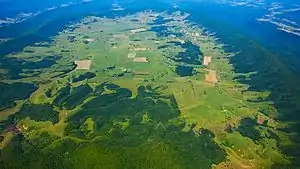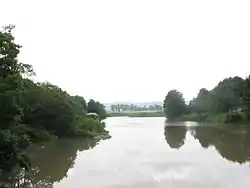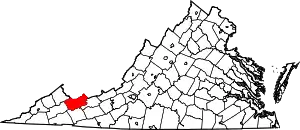Burke's Garden, Virginia
Burke's Garden is an upland valley and unincorporated community in Tazewell County, Virginia.
Burke's Garden | |
|---|---|
 View of Burke's Garden, Virginia, from the center of the basin | |
 Location of Burke's Garden, Virginia | |
| Coordinates: 37°10′12″N 81°23′04″W | |
| Country | United States |
| State | Virginia |
| County | Tazewell |
| Elevation | 3,074 ft (937 m) |
| Population (Now) | |
| • Total | about 300 |
| • Density | 0.001/sq mi (0.01/km2) |
| Time zone | UTC-5 (Eastern (EST)) |
| • Summer (DST) | UTC-4 (EDT) |
| Area code(s) | 276 |
| GNIS feature ID | 1498460[1] |

Geography and geology
The oval, bowl-like valley (or "cove") is known for its fertile land and was once the bed of an ancient sea. About 8.5 miles (13.7 km) long and 4 miles (6.4 km) wide, it resembles a large volcanic crater in satellite photographs and on topographic maps; however, it was formed when underground limestone caverns collapsed. The mountain valley is the second highest in Virginia at around 3,000 feet (910 m) above sea level and is completely surrounded by Garden Mountain.[2] This unusual topography is similar to that of Canaan Valley in neighboring West Virginia.

History
The area was long occupied by varying cultures of indigenous peoples.
Burke's Garden was first surveyed in 1748 by a team of surveyors working for local landowner James Patton. One of the party, James Burke an Irishman, is said to have thrown away some potato peelings while cooking. A year later, when the party returned to the area, they found potatoes growing in the area where the peels had been left. The area was dubbed Burke's Garden as something of a joke, but the name stuck. The community was an outpost of German immigrants who settled in the backcountry frontier in the late 18th century.[3]
The area remained relatively isolated as it was not near the transportation corridors of major rivers. In the late 19th century, agents for the Vanderbilt family contacted local farmers about selling land so that the family could build a large estate there. Nobody wanted to sell, and the Vanderbilts instead constructed their Biltmore Estate near Asheville, North Carolina.[4] In the 1990s, a small number of Amish families moved to Burke's Garden, but later they moved out after being unable to purchase enough land and attract enough other Amish families to form a viable community.[5] Today Amish have returned to Burkes Garden and have a thriving community. Lines of scooters can be seen daily outside the Burkes Garden School and Community Center where the Amish now have their own school.
The county's oldest church, the Central Lutheran church, is located in Burke's Garden. It originally served multiple denominations so was called Union Church. When the congregation learned their Union Church had joined the Lutheran denomination most members left and established Methodist and Presbyterian churches. In 1952, the community was terrorized by the "Varmint of Burke's Garden", a large coyote that killed many local sheep and caused much damage before being killed.
The area is drained by Wolf Creek (a tributary of the New River) which flows out of the geographic bowl in a northeasterly direction.
The entire valley is listed on the National Register of Historic Places as the Burke's Garden Rural Historic District; the Burke's Garden Central Church and Cemetery is also listed on the NRHP.[6]
References
- "US Board on Geographic Names". United States Geological Survey. 2007-10-25. Retrieved 2008-01-31.
- "Burke's Garden". Virginia is for lovers. Virginia Tourism Corporation. Retrieved 25 September 2015.
- Virginia Historic Landmarks Commission Staff (November 1978). "National Register of Historic Places Inventory/Nomination: Burkes Garden Central Church and Cemetery" (PDF). Virginia Department of Historic Resources. and Accompanying photo and Accompanying map
- "Burke's Garden: God's Thumbprint". Appalachian Magazine. 24 January 2017. Retrieved 24 March 2018.
- Tennis, Joe (May 6, 2010). "A Different World". Virginia Living. Cape Fear Publishing. Retrieved June 27, 2016.
- "National Register Information System". National Register of Historic Places. National Park Service. July 9, 2010.
- Fenneman, Nevin M. (1938), Physiography of Eastern United States, New York and London: McGraw-Hill Book Company, Inc., pp 251, 254.
External links
| Wikimedia Commons has media related to Burke's Garden, Virginia. |


